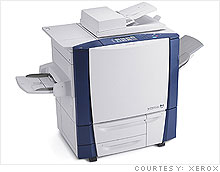Xerox bets on pricey printers
Copier maker defies tough economy by offering a premium product.
 |
| Xerox's ColorQube printer comes with a big price tag, but the company says it will save on color printouts. |
NEW YORK (Fortune) -- Now may not seem like the ideal time to launch a high-end product aimed at the business world, but that is just what Xerox decided to do when it unveiled its new ColorQube solid-ink multifunction printer series in May.
Xerox (XRX, Fortune 500) is betting that businesses will be willing to pay a hefty price tag up front (the machines cost $23,500 to $29,000) for more affordable color printouts that are about 62% cheaper than current rates.
According to Xerox companies that use color printers shell out around eight cents per color page, regardless of the amount of color ink used. With Xerox's new printer customers essentially pay only for the color they use, and a simpler "infrastructure" that results in a lower average cost per page for color printouts.
"This is the time when people are scrounging to save money and looking to differentiate themselves," says Ursula Burns, who has been appointed chief executive officer of the Norwalk, Conn.-based equipment maker, effective July 1. (Burns is president of Xerox.) "We give them something to do both those things."
Xerox isn't the only company offering expensive gear at a time when many companies and consumers are tightening their belts. Amazon's new Kindle will retail for nearly $500. Samsung just started selling LED televisions that start at $1,600 a pop. Time will reveal whether these recession-era product launches are prescient or foolhardy.
Still, the big bet comes at a tough time for Xerox and its CEO-in-waiting: The copier and printer maker saw sales fall 18% in the first quarter, to $3.6 billion. (It posted a $42 million profit, reversing a year-ago loss.) Xerox says it is able to offer this sort of "pay-per-use" model thanks to its solid-ink technology, which the company has used in smaller desktop devices for years. But this is the first time the technology has been used in large office printers.
The machines work by melting crayon-like blocks of ink. Each color of ink gets sprayed onto a drum before it is transferred to paper. The printers use no ink cartridges (which, Xerox notes, is good for the environment) have less packaging than laser devices, and use only one consumable part that lasts over 200,000 prints.
Analysts agree that the new printers seem to provide several advantages over their laser counterparts. But just how big of a gamble is Xerox taking by launching this product now?
Last year Xerox was still the leader in color device shipments with 23% of the market share, according to IDC. To take a larger share of the pie, Xerox is betting corporations will want to bolster their color printing, and that the ColorQube won't eat away at Xerox's own color laser sales.
"Clearly what Xerox wants is to have this product erode the laser business of their competitors," says Angele Boyd, an analyst at IDC. "But every time you pitch against laser from your competitor, essentially you have to do the same thing against your own laser product line." The big question, of course, is whether companies will invest in a high-priced product right now, despite potential cost savings.
"It's a good time to launch a product whose main advantage is to help save money," says Steve Reynolds, a senior analyst at Lyra Research. "It's a bad time to launch because there are a lot of people in the market that are not buying right now." Meanwhile, Xerox rival Hewlett-Packard seems undaunted by the ColorQube line. Tom Codd, the director of marketing at HP, says the company has no plans to stage a counter campaign in light of the new competition.
"They (solid ink printers) were actually a great solution for when everyone was printing a lot of PowerPoint. But the fact of the matter is, people aren't printing as much PowerPoint as they used to," says Codd.
Despite the ostensible risks, Xerox is betting more offices will turn to solid ink. Jim Rise, VP of office printing at Xerox, says he anticipates the company will take market share, and give the competition a run for their money.
Indeed, technology that promises to save money and the environment could just be the recipe for success in a downturn. ![]()
-
 The retail giant tops the Fortune 500 for the second year in a row. Who else made the list? More
The retail giant tops the Fortune 500 for the second year in a row. Who else made the list? More -
 This group of companies is all about social networking to connect with their customers. More
This group of companies is all about social networking to connect with their customers. More -
 The fight over the cholesterol medication is keeping a generic version from hitting the market. More
The fight over the cholesterol medication is keeping a generic version from hitting the market. More -
 Bin Laden may be dead, but the terrorist group he led doesn't need his money. More
Bin Laden may be dead, but the terrorist group he led doesn't need his money. More -
 U.S. real estate might be a mess, but in other parts of the world, home prices are jumping. More
U.S. real estate might be a mess, but in other parts of the world, home prices are jumping. More -
 Libya's output is a fraction of global production, but it's crucial to the nation's economy. More
Libya's output is a fraction of global production, but it's crucial to the nation's economy. More -
 Once rates start to rise, things could get ugly fast for our neighbors to the north. More
Once rates start to rise, things could get ugly fast for our neighbors to the north. More







